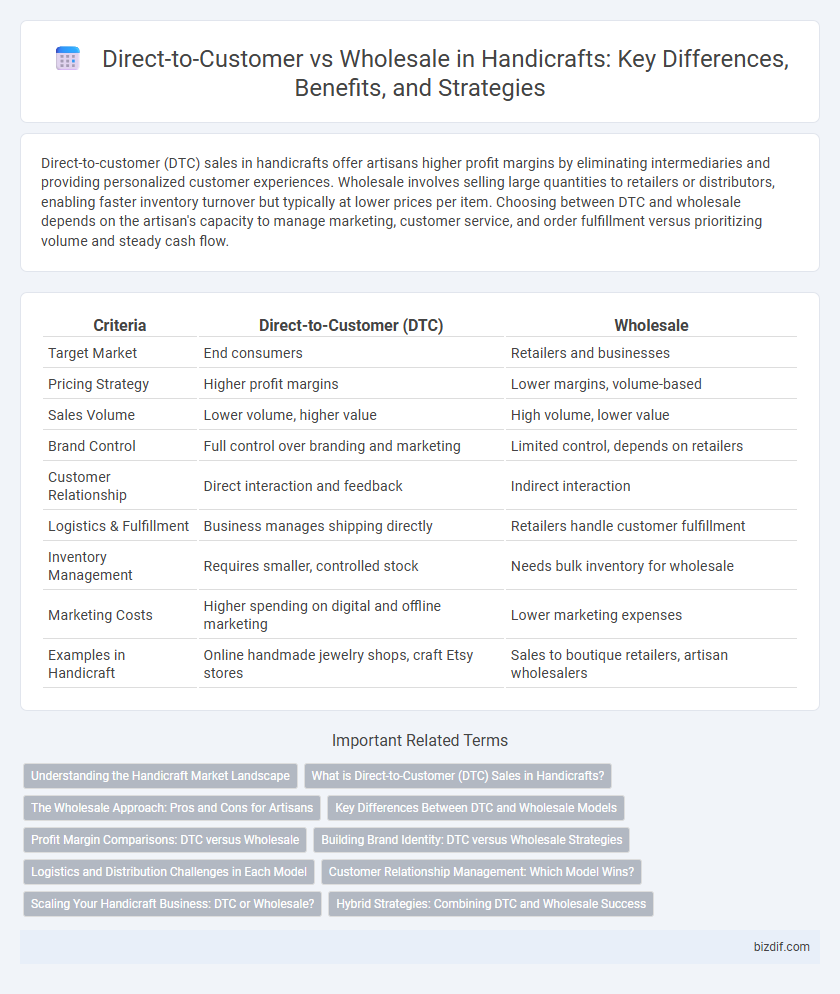Direct-to-customer (DTC) sales in handicrafts offer artisans higher profit margins by eliminating intermediaries and providing personalized customer experiences. Wholesale involves selling large quantities to retailers or distributors, enabling faster inventory turnover but typically at lower prices per item. Choosing between DTC and wholesale depends on the artisan's capacity to manage marketing, customer service, and order fulfillment versus prioritizing volume and steady cash flow.
Table of Comparison
| Criteria | Direct-to-Customer (DTC) | Wholesale |
|---|---|---|
| Target Market | End consumers | Retailers and businesses |
| Pricing Strategy | Higher profit margins | Lower margins, volume-based |
| Sales Volume | Lower volume, higher value | High volume, lower value |
| Brand Control | Full control over branding and marketing | Limited control, depends on retailers |
| Customer Relationship | Direct interaction and feedback | Indirect interaction |
| Logistics & Fulfillment | Business manages shipping directly | Retailers handle customer fulfillment |
| Inventory Management | Requires smaller, controlled stock | Needs bulk inventory for wholesale |
| Marketing Costs | Higher spending on digital and offline marketing | Lower marketing expenses |
| Examples in Handicraft | Online handmade jewelry shops, craft Etsy stores | Sales to boutique retailers, artisan wholesalers |
Understanding the Handicraft Market Landscape
Direct-to-customer (DTC) sales in the handicraft market enable artisans to build personalized relationships, retain higher profit margins, and showcase the authenticity of their handmade products. Wholesale channels provide access to broader retail networks, allowing for larger volume sales but often at reduced prices and less brand control. Understanding these dynamics is crucial for handicraft businesses to balance market reach, pricing strategies, and customer engagement effectively.
What is Direct-to-Customer (DTC) Sales in Handicrafts?
Direct-to-Customer (DTC) sales in handicrafts involve artisans selling their handmade products directly to consumers without intermediaries, enhancing profit margins and customer engagement. This approach allows craftsmen to build personalized relationships, gather immediate feedback, and maintain full control over branding and pricing. DTC channels often include online marketplaces, social media platforms, and craft fairs, which facilitate direct marketing and distribution.
The Wholesale Approach: Pros and Cons for Artisans
The wholesale approach allows artisans to reach a broader market by partnering with retailers who purchase large quantities of handcrafted products, which ensures steady cash flow and reduces the need for individual customer handling. However, this method often involves lower profit margins per item and less control over brand presentation and pricing. Artisans must balance the benefits of volume sales with potential dilution of brand identity and reliance on retailer partnerships.
Key Differences Between DTC and Wholesale Models
Direct-to-Customer (DTC) models enable artisans to sell handcrafted products directly to consumers, offering higher profit margins and greater brand control. Wholesale involves selling large quantities of handicrafts to retailers at lower prices, allowing broader market reach but with reduced per-unit revenue. Inventory management, marketing strategies, and customer engagement significantly differ between DTC and wholesale approaches in the handicraft industry.
Profit Margin Comparisons: DTC versus Wholesale
Direct-to-customer (DTC) sales in handicrafts generally yield higher profit margins, often ranging from 50% to 70%, due to the elimination of intermediaries and direct price control. Wholesale margins typically fall between 20% and 40%, reflecting bulk discounts and retailer markups that reduce individual product profitability. DTC channels require greater marketing investment but enable artisans to build brand equity and retain greater revenue per sale compared to wholesale distribution.
Building Brand Identity: DTC versus Wholesale Strategies
Direct-to-customer (DTC) strategies enable handicraft businesses to build a strong brand identity by engaging directly with consumers, fostering personalized experiences, and showcasing authentic craftsmanship. Wholesale, while expanding market reach, often dilutes brand storytelling as products become one among many in larger retail environments, reducing control over customer perception. Emphasizing DTC channels allows artisans to maintain consistency in brand messaging, create niche loyalty, and gather valuable consumer feedback to refine their offerings.
Logistics and Distribution Challenges in Each Model
Direct-to-customer (D2C) handicraft businesses face logistics challenges such as managing numerous small shipments, ensuring timely delivery, and handling individual customer service needs. Wholesale models streamline distribution by shipping bulk orders to retailers or distributors, but require robust inventory management and coordination with multiple intermediaries. Both approaches demand efficient supply chain solutions, but D2C prioritizes last-mile delivery and personalized packaging, while wholesale emphasizes volume consolidation and consistent product availability across retail channels.
Customer Relationship Management: Which Model Wins?
Direct-to-Customer (D2C) in handicraft businesses enhances Customer Relationship Management (CRM) by enabling personalized interactions, real-time feedback, and tailored experiences that build lasting loyalty. Wholesale models, while efficient for volume sales, often dilute direct customer engagement, limiting opportunities for deep relationship development and responsive support. Prioritizing CRM through D2C channels fosters stronger brand connection, higher customer satisfaction, and increased lifetime value in the competitive handicraft market.
Scaling Your Handicraft Business: DTC or Wholesale?
Scaling your handicraft business involves choosing between Direct-to-Customer (DTC) and wholesale models, each offering distinct advantages for growth. DTC enables higher profit margins and direct brand engagement through platforms like Shopify and Etsy, while wholesale provides larger distribution and volume-based revenue by partnering with retailers. Optimizing your approach depends on balancing personalized customer relationships with expanding market reach to maximize sales and brand visibility.
Hybrid Strategies: Combining DTC and Wholesale Success
Hybrid strategies in the handicraft industry leverage the strengths of both Direct-to-Customer (DTC) and wholesale models to maximize market reach and revenue. Artisans maintain brand control and higher profit margins through DTC channels while expanding distribution and customer base via wholesale partnerships. Integrating online platforms for DTC sales with traditional wholesale relationships creates a balanced ecosystem that enhances brand visibility and sustains growth.
Direct-to-Customer vs Wholesale Infographic

 bizdif.com
bizdif.com